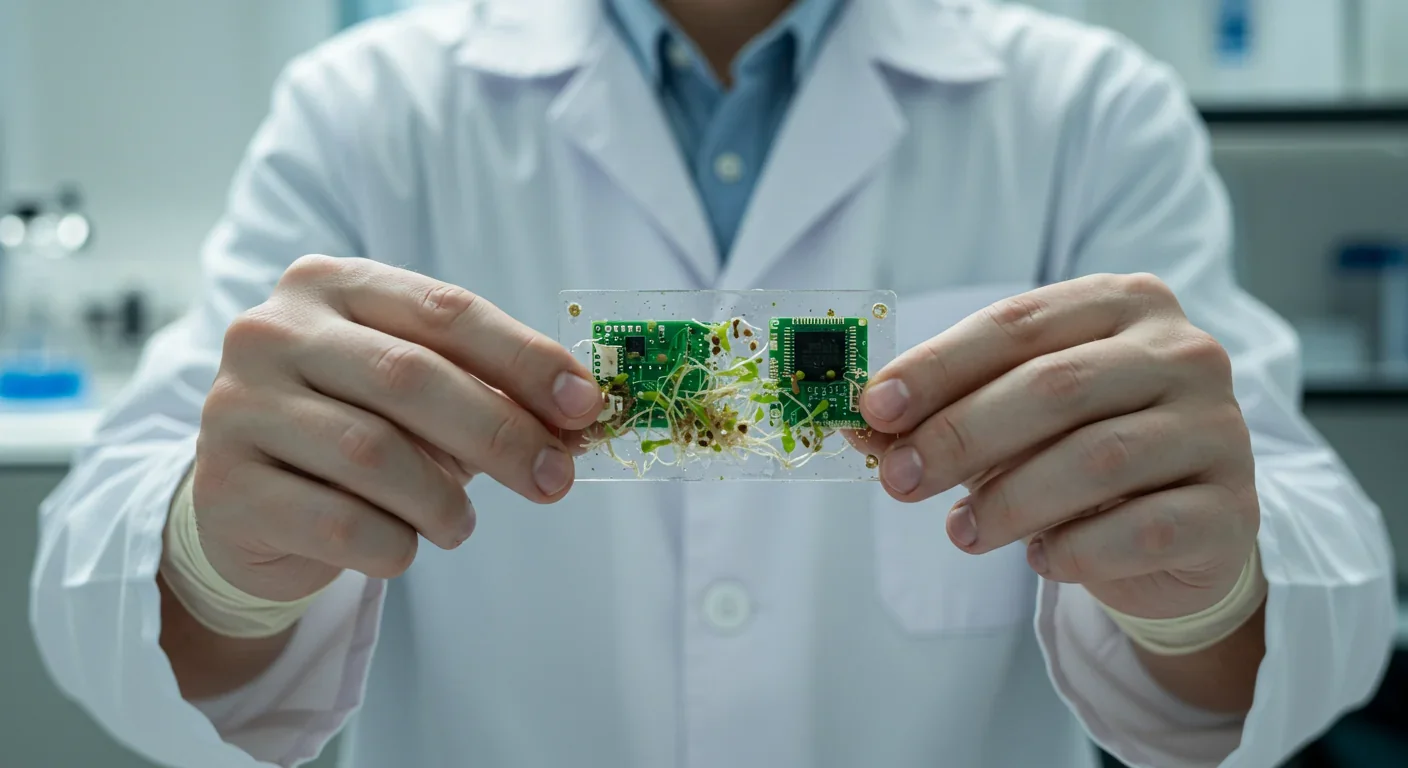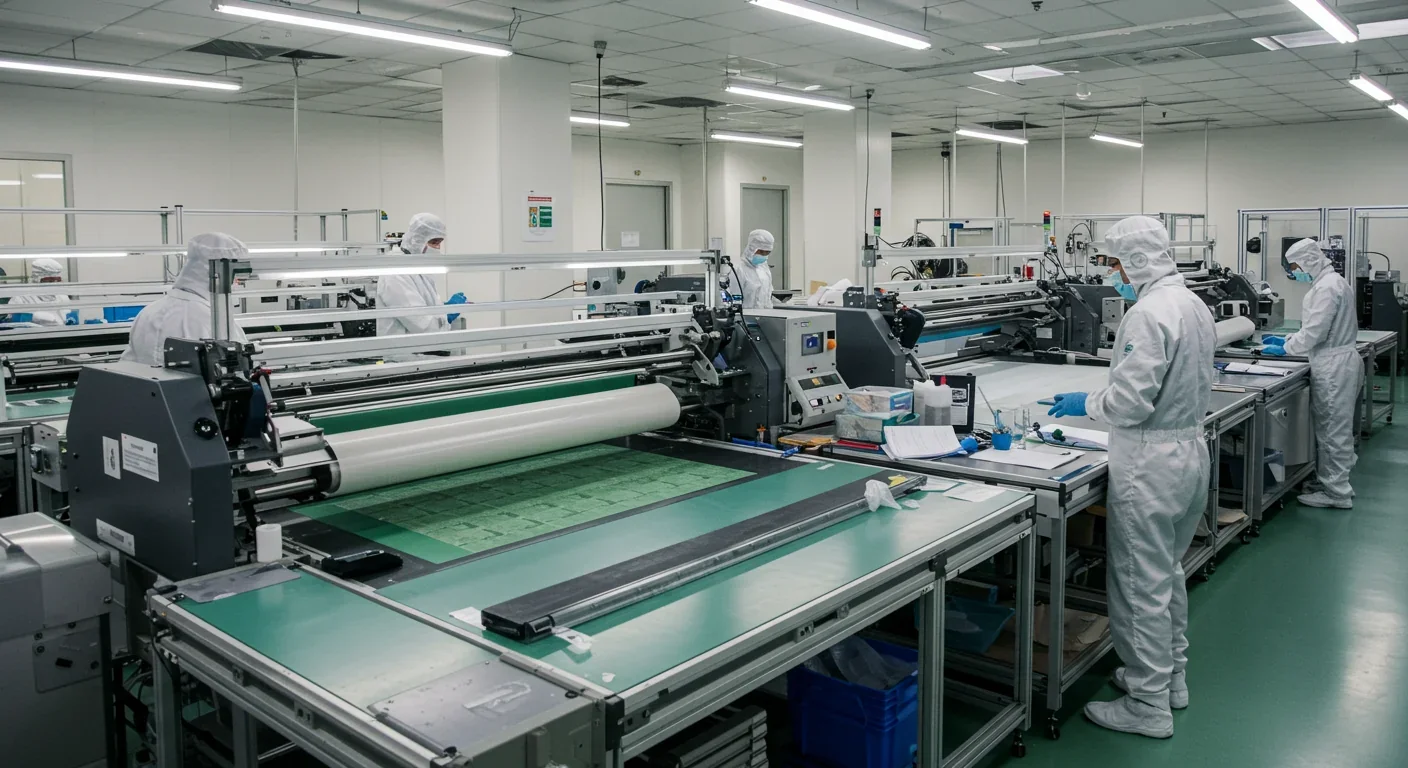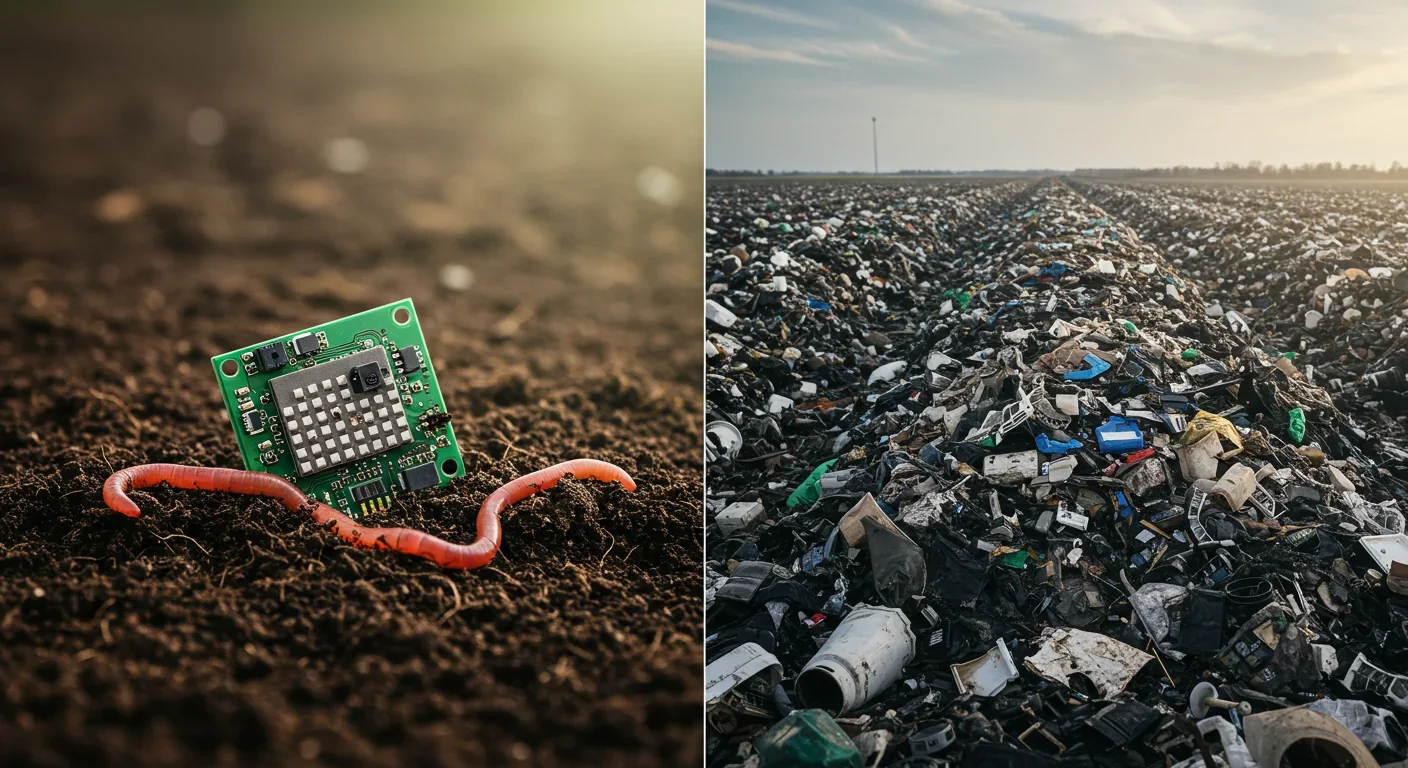Digital Pollution Tax: Can It Save Data Centers?

TL;DR: Scientists are developing electronics that safely decompose after use, using biodegradable polymers, water-based semiconductors, and air-doped conductive materials to combat the 62 million tons of toxic e-waste generated annually.

By 2030, researchers predict that the first generation of truly compostable smartphones could hit the market. Not recyclable. Not just biodegradable packaging. We're talking about devices that dissolve harmlessly back into the earth after their useful life, leaving nothing but nutrients behind. What sounds like science fiction is rapidly becoming scientific fact, driven by a convergence of materials science breakthroughs, environmental urgency, and a fundamental reimagining of what electronics can be.
Every year, humanity generates over 62 million tons of electronic waste, enough to fill a line of garbage trucks stretching from New York to Bangkok. Less than 20% gets properly recycled. The rest ends up in landfills or incinerators, leaching toxic heavy metals like lead, mercury, and cadmium into soil and water for centuries. Traditional electronics weren't designed to disappear; they were engineered for exactly the opposite: durability, longevity, resistance to degradation.
But what if we flipped that script entirely? What if, instead of fighting against nature's decomposition processes, we harnessed them?
That's the radical proposition behind transient electronics, a field that's quietly revolutionizing how we think about technology's relationship with the environment. The core insight is elegant: engineer devices to vanish on a predictable schedule, matching their physical lifespan to their functional utility. A medical implant that monitors healing for two weeks, then safely dissolves. An environmental sensor that tracks river pollution for a season, then biodegrades completely. A smartphone that composts after three years of use.
The breakthrough hinges on replacing silicon and toxic metals with nature-friendly alternatives that still conduct electricity. Scientists have identified several promising material families, each with distinct properties and applications.
Biodegradable polymers form the structural backbone. Polylactic acid (PLA) and polyglycolic acid (PGA), already used in dissolvable surgical sutures, provide insulating layers and substrates. These corn-starch-derived plastics break down into lactic acid and glycolic acid, both naturally occurring compounds that microbes readily consume.
Sacrificial metals serve as conductors and electrodes. Magnesium, zinc, and iron corrode predictably in water or humid air, and their degradation products—mostly oxides and hydroxides—are far less toxic than the heavy metals in conventional circuits. Researchers can fine-tune corrosion rates by alloying metals or applying surface treatments, giving designers precise control over device lifetime.
Organic semiconductors represent perhaps the most exciting frontier. Unlike silicon, which requires energy-intensive purification and doping with toxic elements, organic semiconductors can be printed from water-based inks at room temperature. A 2024 study from Linköping University demonstrated that conductive polymers processed in water actually outperform their toxic-solvent counterparts, achieving higher stability and efficiency in solar cells.
Even more remarkable: scientists have figured out how to dope organic semiconductors using nothing but air and light. By dipping conductive plastic into a photocatalyst solution and briefly illuminating it, researchers can control electrical properties without any hazardous chemicals. The process consumes only atmospheric oxygen, and the photocatalyst solution can be recovered and reused indefinitely.
Dissolvable oxides and silicon structures round out the toolkit. Porous silicon degrades in water within hours to weeks, depending on porosity. Silicon dioxide and magnesium oxide serve as dielectrics and protective layers, eventually dissolving into biocompatible silicates.

Creating electronics that vanish requires a fundamental shift in engineering philosophy. Traditional design prizes durability; every component is selected and protected to resist environmental degradation. Compostable electronics flip that logic. Engineers must now orchestrate instability, crafting precise pathways for controlled decomposition.
This involves several key strategies. Triggered degradation uses external cues to initiate breakdown. Exposure to water, changes in pH, or specific wavelengths of light can flip a device from stable operation to rapid dissolution. Encapsulation timing protects components during use but allows moisture penetration afterward. Thin polymer coatings or wax barriers dissolve first, exposing reactive metals and polymers to the environment on schedule.
Layered architectures sequence the disassembly process. The outer casing might dissolve in days, internal circuitry in weeks, and core components in months—each layer timed to its function. Material compatibility ensures that degradation products don't interfere with each other or create toxic compounds. Magnesium electrodes, for instance, produce alkaline conditions as they corrode, which can accelerate polymer breakdown.
Manufacturing these devices demands new techniques. Solution processing methods—including inkjet printing, screen printing, and spray coating—allow ambient-temperature fabrication without harsh chemicals. Roll-to-roll printing can produce flexible circuits on biodegradable substrates at industrial scale, potentially rivaling conventional semiconductor manufacturing in efficiency.
The simultaneous p- and n-doping capability of photocatalytic doping simplifies device assembly significantly. Traditional electronics require separate processes for creating positive and negative charge carriers; the new method achieves both in a single step, reducing manufacturing complexity and cost.
Several organizations have moved beyond proof-of-concept to functioning devices. PARC (Palo Alto Research Center) developed transient RFID tags for supply chain management. These paper-thin identifiers track shipments through the distribution network, then harmlessly degrade in landfills rather than contributing to electronic waste.
Medical applications show particular promise. Researchers have created implantable sensors for post-operative monitoring that dissolve completely after healing, eliminating the need for surgical removal. Dissolvable drug delivery systems can release medications on precisely timed schedules, then vanish without trace.
Environmental monitoring represents another ideal use case. Biodegradable sensors deployed in rivers, forests, or agricultural fields can collect data for weeks or months, then safely break down into the ecosystem they're monitoring. No retrieval necessary, no lasting environmental footprint.
The consumer electronics sector remains the holy grail, but progress is accelerating. While we're not yet composting our smartphones, prototypes of biodegradable wearables and sensors demonstrate that everyday devices could follow. Fitness trackers, disposable diagnostic tools, and temporary communication devices are all within reach of current technology.
Life cycle analysis reveals a nuanced picture. Compostable electronics offer clear advantages in end-of-life disposal—no toxic leaching, no need for energy-intensive recycling, no accumulation in landfills. But manufacturing impacts depend heavily on material sourcing and production methods.
Growing PLA from corn requires agricultural land, water, and fertilizer. Extracting magnesium involves its own environmental costs. The key advantage: these materials cycle through natural systems rather than persisting indefinitely. A 2024 assessment found that even accounting for production impacts, biodegradable devices could reduce overall environmental harm by 60-80% compared to conventional electronics in applications with short functional lifespans.
The degradation products themselves require scrutiny. While far safer than heavy metals, metal ions from corroding electrodes can affect soil chemistry and aquatic ecosystems. Researchers emphasize careful dose-response studies and environmental monitoring, especially for large-scale deployments.
Interestingly, sustainable chemistry integration in manufacturing offers benefits beyond the final product. Water-based processing eliminates worker exposure to toxic solvents, improving occupational health in fabrication facilities. Photocatalytic doping uses only ambient air and light, slashing chemical waste from production.

Current costs exceed conventional electronics by 2-5x, depending on application. But economies of scale could close that gap rapidly. Organic semiconductor manufacturing requires far less capital investment than silicon fabrication plants, which cost billions of dollars. Printing circuits on flexible substrates using existing industrial equipment offers a lower barrier to entry.
Several market forces favor adoption. Regulatory pressure is mounting; the European Union's Right to Repair legislation and extended producer responsibility laws create incentives for more sustainable devices. Corporate sustainability commitments, driven by investor pressure and consumer preference, are pushing electronics companies to explore alternatives.
Niche applications where retrieval is impractical or expensive present immediate opportunities. Medical implants, environmental sensors, agricultural monitors, and military applications all value devices that disappear on schedule. The global market for biodegradable electronics is projected to reach $2.7 billion by 2030, growing at 23% annually.
Performance gaps remain the primary barrier for consumer applications. Organic semiconductors typically lag silicon in switching speed, though recent advances have produced conductivities exceeding traditional materials in some contexts. Battery technology presents particular challenges; truly compostable energy storage remains elusive, with most biodegradable devices relying on external power or conventional batteries that must be removed before disposal.
Governing bodies face the challenge of creating standards for a technology that's designed to disappear. Traditional e-waste regulations focus on collection, recycling, and proper disposal. Transient electronics require new frameworks addressing degradation rates, byproduct toxicity, and environmental safety.
The FDA has begun developing pathways for biodegradable medical devices, requiring demonstration of predictable dissolution and biocompatibility of degradation products. European environmental agencies are exploring certification systems for compostable electronics, analogous to existing standards for biodegradable packaging.
Industry consortia are working to establish best practices before regulations solidify. This includes standardized testing protocols for degradation rates under various environmental conditions, safety thresholds for metal ion release, and labeling requirements to prevent contamination of conventional recycling streams.
Research leadership is distributed globally, with distinct regional strengths. European universities, particularly in Sweden and Italy, pioneered water-based organic semiconductor processing. Asian research institutions, especially in China, Japan, and South Korea, are advancing manufacturing scalability and commercial applications. American universities and research centers like PARC focus on defense and medical applications.
This geographic distribution reflects different priorities and regulatory environments. Europe's stringent environmental regulations create strong incentives for sustainable electronics. Asia's manufacturing expertise accelerates translation from lab to market. North America's medical device sector provides funding and use cases for biodegradable implants.
International collaboration is increasing, with materials scientists, chemists, electrical engineers, and environmental scientists working across disciplines and borders. The Nature Communications and Nature publications from 2024 involved multi-institutional teams spanning several countries, reflecting the field's collaborative nature.
Within a decade, you'll likely encounter compostable electronics in everyday life, though perhaps not where you expect. Your first biodegradable device probably won't be a smartphone—it might be a medical monitor during a hospital stay, a sensor in a farm field, or a shipping tracker on a package.
For consumers, this shift demands new mental models. We're accustomed to electronics as durable goods, worth repairing and reselling. Transient devices are intentionally ephemeral, designed for the trash—but a trash that feeds soil rather than poisoning it. Learning to distinguish compostable devices from conventional electronics will become important to prevent contamination of both waste streams.
For industries, the implications are profound. Product designers will need expertise in degradation engineering alongside traditional electrical design. Supply chains must adapt to materials with shorter shelf lives. Business models might shift from selling durable goods to providing device-as-a-service, where biodegradable units are regularly replaced and composted.
For policymakers, the technology offers tools to address e-waste without relying solely on recycling infrastructure, which consistently fails to keep pace with growing waste volumes. Mandating compostable electronics for specific applications—medical devices, agricultural sensors, temporary installations—could significantly reduce toxic waste while spurring innovation.
Compostable electronics won't replace conventional devices entirely, at least not soon. Your laptop, designed for years of intensive use, makes little sense as a biodegradable device. But the 80% of electronics discarded within three years present different opportunities. Smartphones, wearables, sensors, and IoT devices all have functional lifespans that could align with designed decomposition.
The technology's ultimate impact depends on solving remaining challenges. Better biodegradable batteries are crucial for untethered operation. Improving performance to match silicon for more demanding applications will expand the market. Scaling manufacturing while maintaining environmental benefits requires careful attention to supply chains and processing methods.
Perhaps most importantly, compostable electronics represent a philosophical shift: accepting that technology doesn't have to last forever to have lasting value. In a world where 62 million tons of e-waste accumulate annually, devices designed to vanish might be exactly what endures.
The question isn't whether compostable electronics will transform the industry, but how quickly, and whether society can develop the infrastructure and mindsets to support them before e-waste overwhelms our capacity to manage it. In laboratories across the world, that race is already underway, with materials scientists literally printing the future from air and water.

Recent breakthroughs in fusion technology—including 351,000-gauss magnetic fields, AI-driven plasma diagnostics, and net energy gain at the National Ignition Facility—are transforming fusion propulsion from science fiction to engineering frontier. Scientists now have a realistic pathway to accelerate spacecraft to 10% of light speed, enabling a 43-year journey to Alpha Centauri. While challenges remain in miniaturization, neutron management, and sustained operation, the physics barriers have ...

Epigenetic clocks measure DNA methylation patterns to calculate biological age, which predicts disease risk up to 30 years before symptoms appear. Landmark studies show that accelerated epigenetic aging forecasts cardiovascular disease, diabetes, and neurodegeneration with remarkable accuracy. Lifestyle interventions—Mediterranean diet, structured exercise, quality sleep, stress management—can measurably reverse biological aging, reducing epigenetic age by 1-2 years within months. Commercial ...

Data centers consumed 415 terawatt-hours of electricity in 2024 and will nearly double that by 2030, driven by AI's insatiable energy appetite. Despite tech giants' renewable pledges, actual emissions are up to 662% higher than reported due to accounting loopholes. A digital pollution tax—similar to Europe's carbon border tariff—could finally force the industry to invest in efficiency technologies like liquid cooling, waste heat recovery, and time-matched renewable power, transforming volunta...

Humans are hardwired to see invisible agents—gods, ghosts, conspiracies—thanks to the Hyperactive Agency Detection Device (HADD), an evolutionary survival mechanism that favored false alarms over fatal misses. This cognitive bias, rooted in brain regions like the temporoparietal junction and medial prefrontal cortex, generates religious beliefs, animistic worldviews, and conspiracy theories across all cultures. Understanding HADD doesn't eliminate belief, but it helps us recognize when our pa...

The bombardier beetle has perfected a chemical defense system that human engineers are still trying to replicate: a two-chamber micro-combustion engine that mixes hydroquinone and hydrogen peroxide to create explosive 100°C sprays at up to 500 pulses per second, aimed with 270-degree precision. This tiny insect's biochemical marvel is inspiring revolutionary technologies in aerospace propulsion, pharmaceutical delivery, and fire suppression. By 2030, beetle-inspired systems could position sat...

The U.S. faces a catastrophic care worker shortage driven by poverty-level wages, overwhelming burnout, and systemic undervaluation. With 99% of nursing homes hiring and 9.7 million openings projected by 2034, the crisis threatens patient safety, family stability, and economic productivity. Evidence-based solutions—wage reforms, streamlined training, technology integration, and policy enforcement—exist and work, but require sustained political will and cultural recognition that caregiving is ...

Every major AI model was trained on copyrighted text scraped without permission, triggering billion-dollar lawsuits and forcing a reckoning between innovation and creator rights. The future depends on finding balance between transformative AI development and fair compensation for the people whose work fuels it.